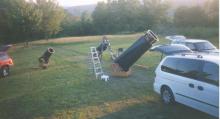Feed aggregator
Innovation 'sifts' space for mysteries
Astronomers and engineers have developed a specialized system for their radio telescope to rapidly detect mysterious fast radio bursts and other space phenomena.
Dwarf planet Ceres: Building blocks of life delivered from space
The dwarf planet is a bizarre, cryovolcanic world. However, the organic deposits discovered on its surface so far are unlikely to originate from its interior. The organic material found in a few areas on the surface of dwarf planet Ceres is probably of exogenic origin. Impacting asteroids from the outer asteroid belt may have brought it with them.
How Titan maintains its atmosphere
Scientists have performed laboratory experiments to better understand how Saturn's moon Titan can maintain its unique nitrogen-rich atmosphere. Titan is the second largest moon in our solar system and the only one that has a significant atmosphere.
Astronomers thought they understood fast radio bursts: A recent one calls that into question
Fast radio bursts are mysterious and brief flashes of radio emissions that were thought to be produced by magnetars, highly magnetized rotating neutron stars. Yet magnetars appear primarily in young star clusters. A repeating burst discovered last year has been pinpointed to the distant outskirts of an old but massive elliptical galaxy where, theoretically, such stars would long since have disappeared. Does this mean magnetars are not the source of FRBs?
Extreme supersonic winds measured on planet outside our Solar System
Astronomers have discovered extremely powerful winds pummeling the equator of WASP-127b, a giant exoplanet. Reaching speeds up to 33,000 km/h, the winds make up the fastest jet-stream of its kind ever measured on a planet. The discovery provides unique insights into the weather patterns of a distant world.
First fast radio burst traced to old, dead, elliptical galaxy
Astronomers previously thought all FRBs were generated by magnetars formed through the explosions of very young, massive stars. But new FRB is pinpointed to the outskirts of 11.3-billion-year-old galaxy without young, active stars -- calling those assumptions into question. 'Just when you think you understand an astrophysical phenomenon, the universe turns around and surprises us,' researcher says.
NASA's Hubble traces hidden history of Andromeda galaxy
In the years following the launch of NASA's Hubble Space Telescope, astronomers have tallied over 1 trillion galaxies in the universe. But only one galaxy stands out as the most important nearby stellar island to our Milky Way -- the magnificent Andromeda galaxy (Messier 31). It can be seen with the naked eye on a very clear autumn night as a faint cigar-shaped object roughly the apparent angular diameter of our Moon. A century ago, Edwin Hubble first established that this so-called 'spiral nebula' was actually very far outside our own Milky Way galaxy -- at a distance of approximately 2.5 million light-years or roughly 25 Milky Way diameters.
The universe is expanding too fast to fit theories: Hubble tension in crisis
The Universe really seems to be expanding fast. Too fast, even. A new measurement confirms what previous -- and highly debated -- results had shown: The Universe is expanding faster than predicted by theoretical models, and faster than can be explained by our current understanding of physics. This discrepancy between model and data became known as the Hubble tension. Now, results provide even stronger support to the faster rate of expansion.
This tiny galaxy is answering some big questions
Leo P, a small galaxy and a distant neighbor of the Milky Way, is lighting the way for astronomers to better understand star formation and how a galaxy grows. Scientists have reported finding that Leo P 'reignited,' reactivating during a significant period on the timeline of the universe, producing stars when many other small galaxies didn't.












